Here you’ll find a full recipe and cake decorating video tutorial for a DIY homemade wedding cake. This simply decorated and elegant vanilla wedding cake has 2 tiers and comes with full assembly instructions. With the help of this carefully detailed post, this wedding cake recipe is perfectly manageable for any home baker.
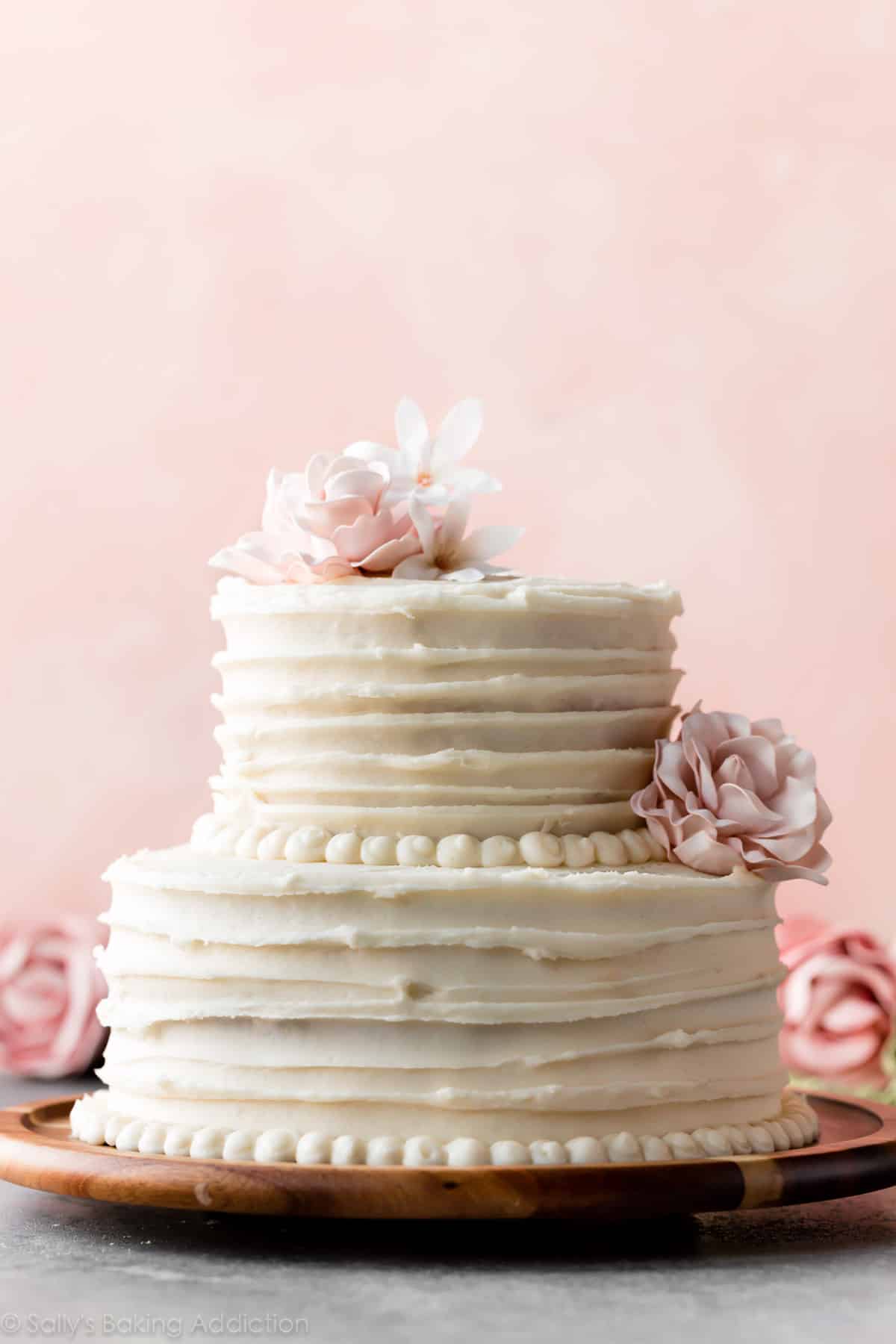
By the request of many readers, let me present you with a homemade 2 tier wedding cake recipe. Adapted from my trusted vanilla cake and 6 inch cake recipes, this from-scratch wedding dessert is not only beautiful—it tastes remarkable, too.
(Isn’t that what counts?)
Fully equipped with complete details and recipe instructions to make this one-of-a-kind dessert, you will wow the happy couple and wedding guests alike. This post has it all.
This DIY Homemade Wedding Cake Is:
- Completely from-scratch
- Manageable for any home baker
- Simple, yet elegant—rustic chic meets traditional
- Complete with a full list of helpful kitchen tools
- Perfect for a small wedding (approximately 30-35 people)
- Wonderful for a larger wedding if other dessert options are available
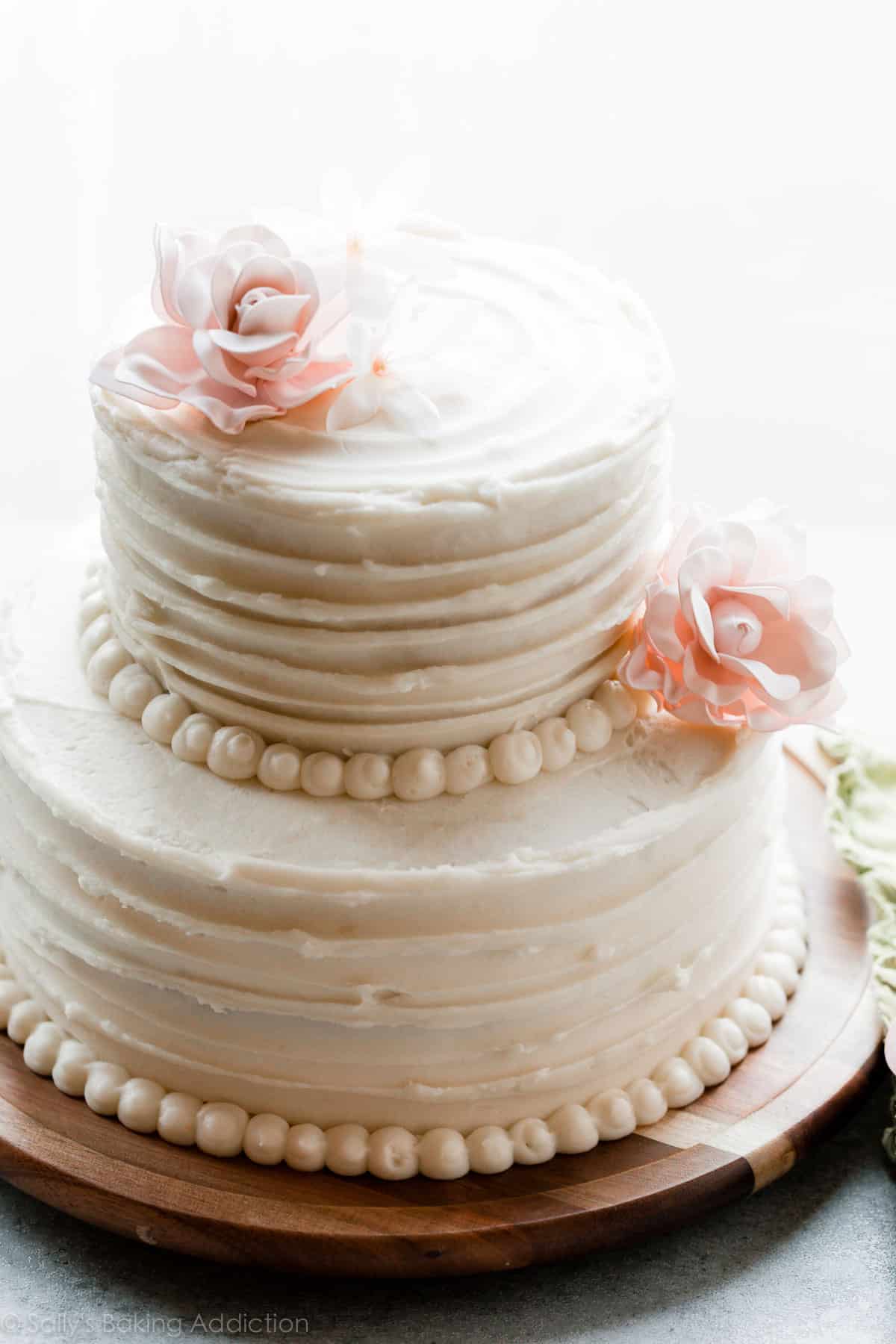
How to Make a DIY Homemade Wedding Cake
This is a 2 tier wedding cake. Both tiers are buttery, soft, and moist. In lieu of traditional fondant, this homemade wedding cake recipe uses my vanilla buttercream, but in a higher quantity. To avoid (1) overwhelming your mixer with excess cake batter and (2) over-mixing or under-mixing the batter, make each cake separately.
- Make each batch of frosting separately too.
Unless you have extra oven(s) or oven space, prepare the cake batters and bake the layer cakes one at a time. Cool the cakes completely before assembling and decorating, which I cover in a separate section below.
Same Ingredients for Both Tiers
Both cakes use the same exact ingredients and each has a special job, so I do not recommend substitutions. Use sugar, cake flour, egg(s), extra egg whites, sour cream, whole milk, and proper room temperature butter. (Among a few other ingredients.) If needed, use this cake flour substitute. Here are recipes that use leftover egg yolks.
- 2-3 batches of lemon curd, which uses egg yolks, would be fantastic as a filling between these cake layers.
The bottom cake is my vanilla cake recipe, but I swap buttermilk for whole milk and sour cream. I do this so you don’t need any varying ingredients for both tiers. (Because the top tier uses whole milk and sour cream.) Sure, you could use buttermilk to replace both the whole milk and sour cream in the 6 inch cake, but whole milk and sour cream are more readily available to most than buttermilk.
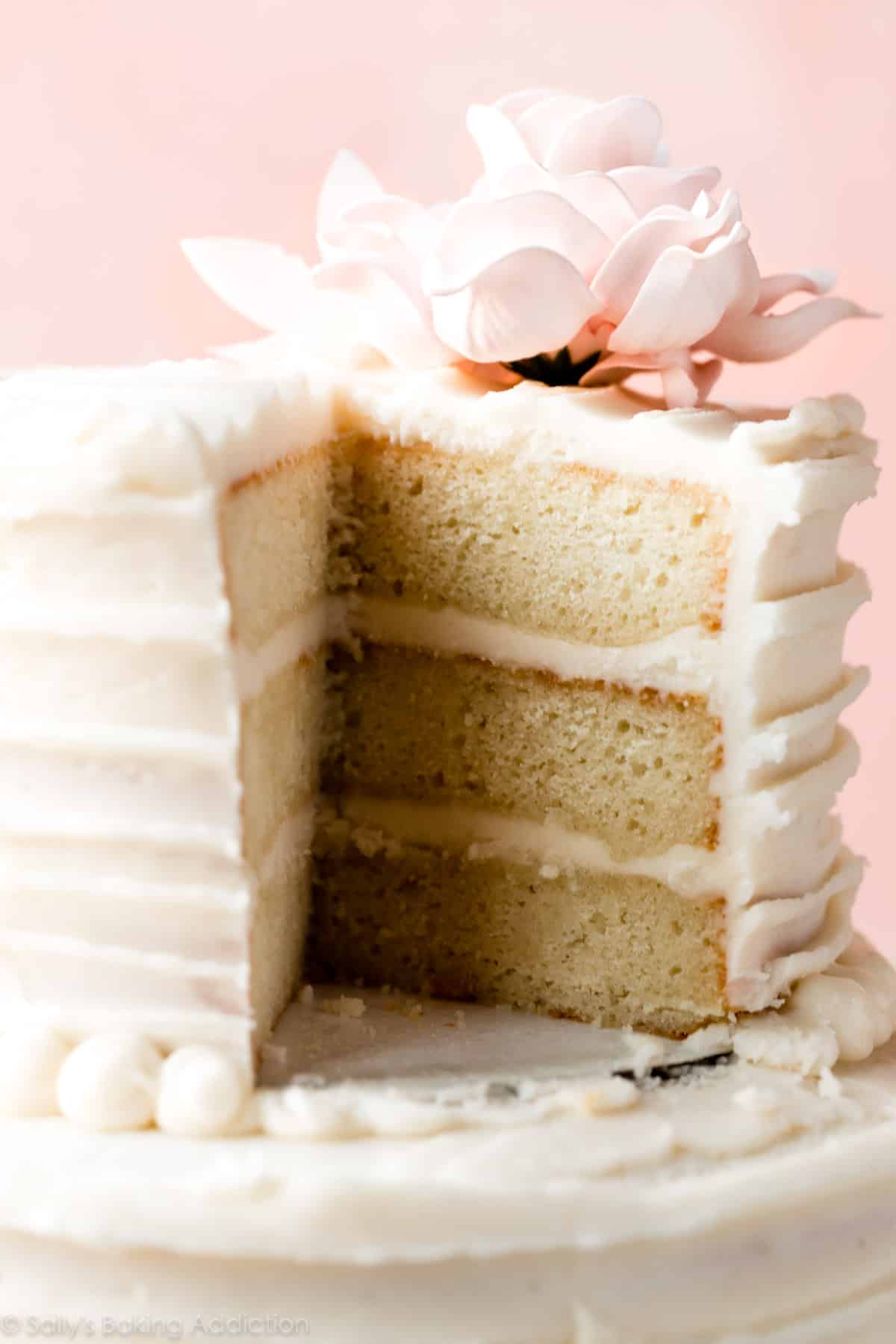
Other Flavor Options
This is vanilla flavored, which is a classic choice to please a variety of wedding guests. You can have fun with frostings, fillings, and flavorings. Here are 5 other cake flavor options:
- Carrot Cake: Use my carrot cake recipe for the bottom tier and make a half batch of the batter for the top tier. Use the same 6 inch cake baking instructions described below.
- Red Velvet Cake: Use my red velvet cake recipe for the bottom tier. You can divide between 3 9-inch cake pans as instructed in the recipe notes. Use my red velvet cupcakes batter for the 6 inch cake. Use the same 6 inch cake baking instructions described below.
- Lemon Cake: Use my lemon cake recipe for the bottom tier. Use my lemon cupcakes batter for the 6 inch cake. Use the same 6 inch cake baking instructions described below.
- Marble Cake: Use my zebra cake for the bottom tier. Use my smaller zebra cake recipe (see this 1st birthday cake) for the 6 inch cake on top.
- Chocolate Chip: After adding the milk in both batters, fold 1 and 1/2 cups (270g) mini chocolate chips into the 9-inch vanilla cake batter and 1 cup (180g) of mini chocolate chips into the 6-inch vanilla cake batter. Regular size chocolate chips would be fine, but mini chocolate chips mean more in each bite.
*These are the only flavors I’ve tested with tiers. At this time, I don’t have a sturdy enough chocolate version to use as the bottom tier.
Want to mix and match flavors? Stick with the vanilla cake on the bottom (or other flavors listed above) and use any cupcake recipes listed in my 6 inch cakes post for the top tier. As explained in that post, cupcake batter yielding between 12-15 cupcakes makes the perfect 3 layer 6 inch cake.
Filling ideas: The filling in my cake is vanilla buttercream, but feel free to use other frosting flavors if desired. You can add extracts to the frosting such as almond, lemon, orange, or coconut. (Start with 1 teaspoon, taste, then add more to taste.) You can even mix a few Tablespoons of raspberry jam into the vanilla buttercream for the filling or use raspberry cake filling.
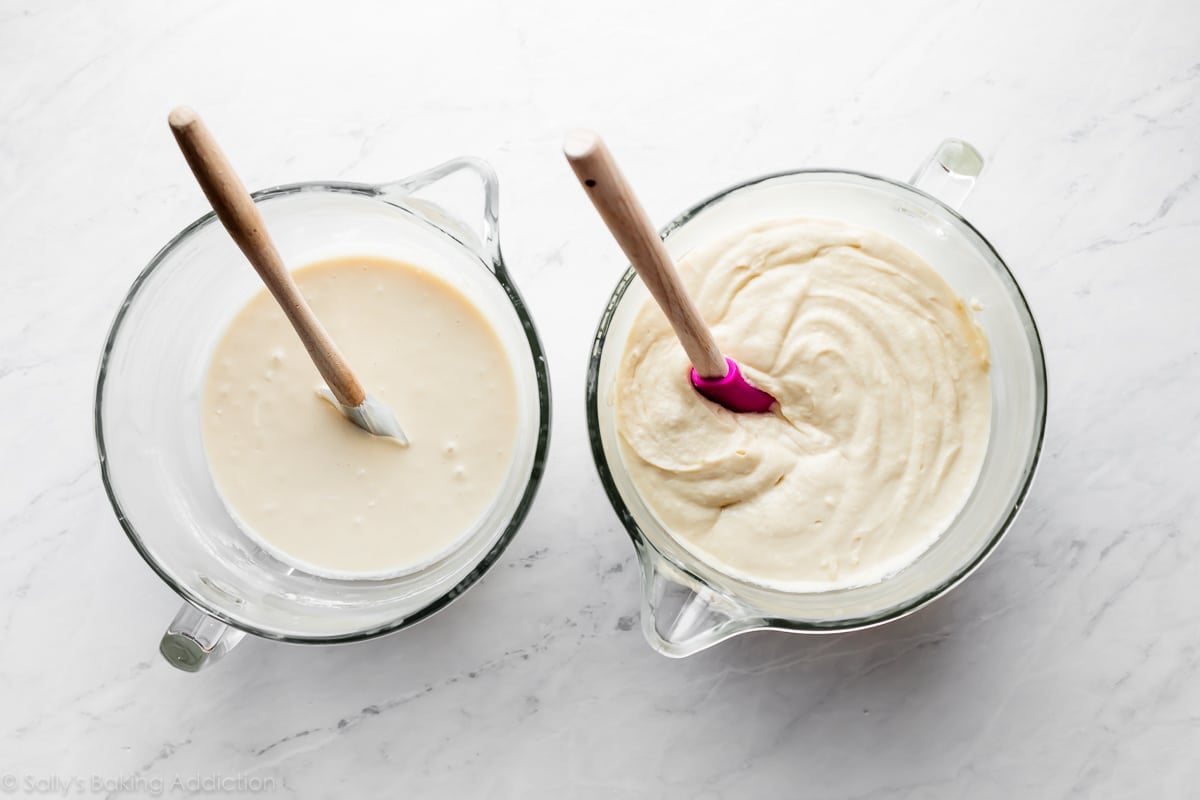
The 6-inch cake batter (left above) is light and creamy. The 9-inch cake batter (right above) is thicker because the bottom tier is a bit denser (for extra support).
Prepare the Wedding Cake Pans
Always line your round pans with parchment paper rounds before adding the batter. Begin by lightly spraying the bottoms and sides of each with nonstick spray or greasing with butter. Add a parchment paper round, then grease the round as well. Parchment paper rounds aren’t something special you need to buy. Simply trace the bottom of your cake pan on regular parchment paper and cut into rounds. Parchment paper rounds guarantee the cooled cakes will seamlessly release from the pans.
See my 10 Cake Baking Tips post for all my advice on baking the BEST cakes.
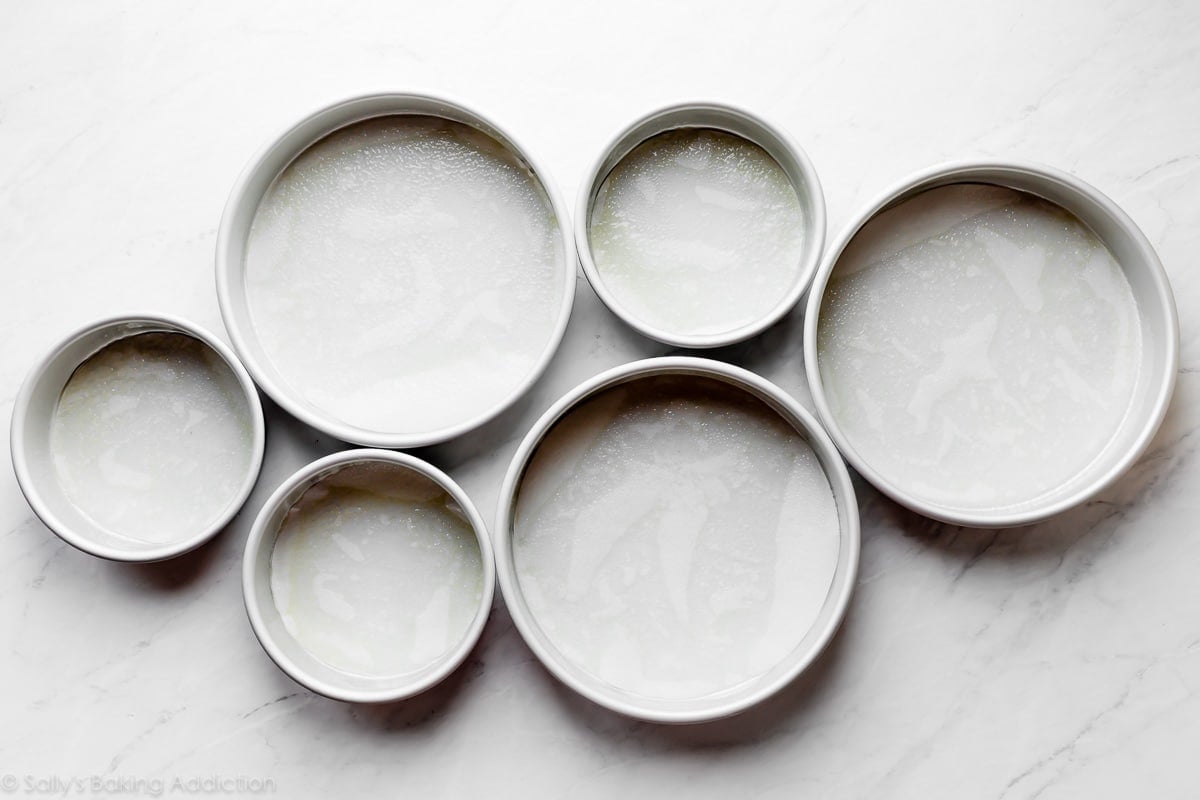
Other Cake Pan Sizes
This recipe uses one 9-inch 3 layer cake and one 6-inch 3 layer cake. The 9-inch cake is 8-9 cups of batter and the 6-inch cake is 4 cups of batter. If you need to substitute other size cake pans, see my Cake Pan Sizes & Conversions post to determine the appropriate amount of batter you need for your desired cake pans.
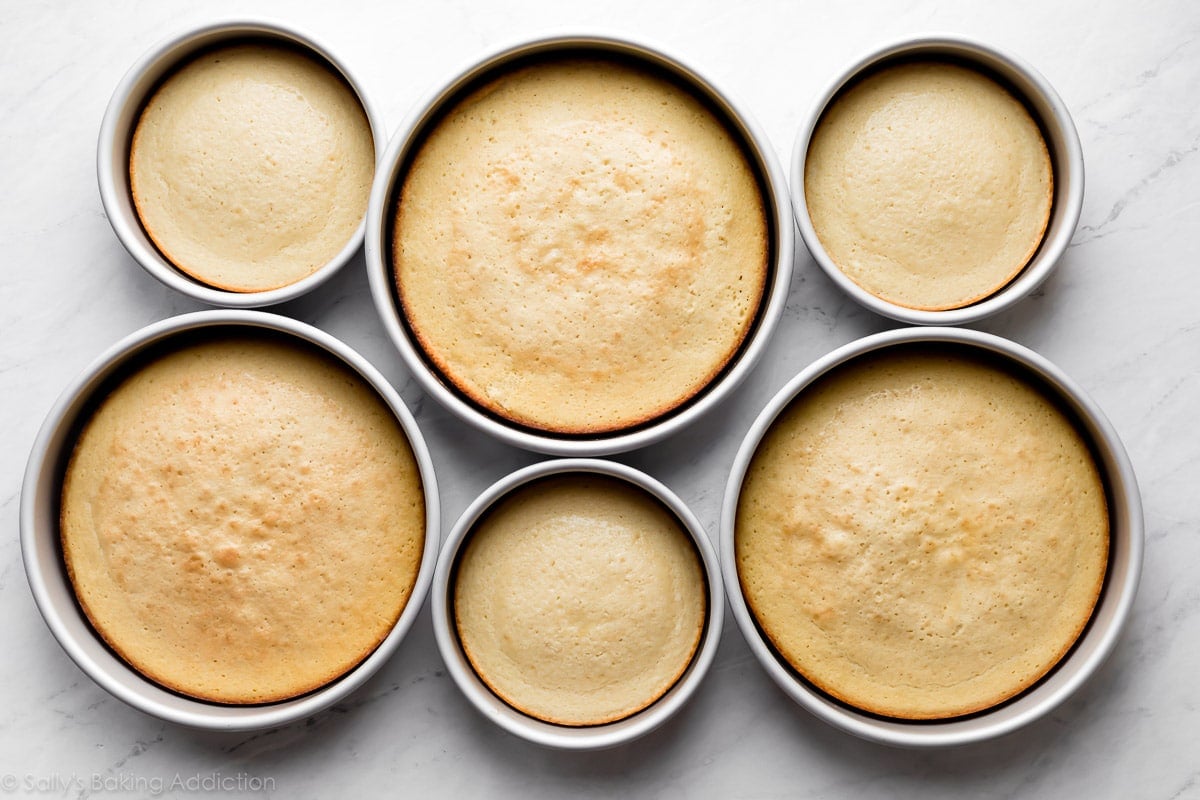
Wedding Cake Video Tutorial (Decorating)
Give the video a few seconds to load right below this text. It’s a faded horizontal image of the cake. Click on the play button in the center to play it. Make sure any ad blockers are temporarily paused on your browser.
How to Assemble & Decorate a Homemade Wedding Cake
Assembling
You are literally making 2 completely separate cakes and placing one on top of the other. For guaranteed support and stability, place 4 cake dowels in the bottom tier. Cake dowels are sticks that will support the top tier. You’ll have to measure and cut the dowels so they are flush with the surface of the bottom cake. Place the small tier on top. A 6-inch cake board, which I describe next, is crucial between the tiers for added support.
*As shown in the video tutorial, crumb coat and decorate both cakes separately before layering the tiers. Decorating instructions are next.
Decorating
Decorate both tiers on cake boards. You can remove the cake board from the bottom tier, if desired, before placing the cake onto a serving platter or cake stand. (This can be tricky!) However, I usually just leave it. A piped frosting border around the bottom of the cake hides it. Do not remove the cake board from the bottom of the top tier. The cake board sits between both tiers for added support and stability and ensures that when you cut into the top tier, the whole cake doesn’t sink down.
A wedding cake is literally the dessert of a lifetime, so it shouldn’t only taste great—it should look stunning, too. To reduce the possibility of flaws or mistakes, stick with simple decorating. A crumb coat on both tiers is necessary to protect the outer layer of frosting from catching any crumbs.
- What is a crumb coat? It’s basically a very thin layer of frosting around the cake before the beautiful exterior frosting is applied. You can see me crumb coating the cakes (as shown in the video tutorial, photos, and described in the recipe below), refrigerate the cakes to help “set” the crumb coat.
As you can see in the video tutorial above, it’s helpful to use a bench scraper to apply the crumb coat and exterior frosting layer. In fact, I use a bench scraper for decorating all layer cakes. I also like to use an icing spatula for the top of the cakes. (I use a small icing spatula for the small cake and a large icing spatula for the large cake.)
After crumb coating the cakes, they must be refrigerated to help “set” the crumb coat. This is another reason why cake boards are necessary—to help transfer/transport the cakes around.
The textured look of the exterior frosting is very easy. (A big shoutout to my assistant, Stephanie, for suggesting this look!) As shown in my video, use a small icing spatula and run it around the cakes while spinning with the cake turner. You will love this look because it’s very easy, but resembles beautiful ruffles.
Piping
After placing the small tier on top, you can pipe frosting around the bottom of it. This covers up any spaces or smears that may have appeared when arranging the top tier. I pipe dots of frosting with a round piping tip between the tiers as well as around the bottom of the whole cake. They resemble pretty pearls. To smooth any peaks on these “pearls,” moisten your fingertip with water and gently press down on the peak.
More Decorating Inspiration
- Naked Cake style with flowers and berries
- Buttercream Flowers
- Two-Toned Frosting Roses
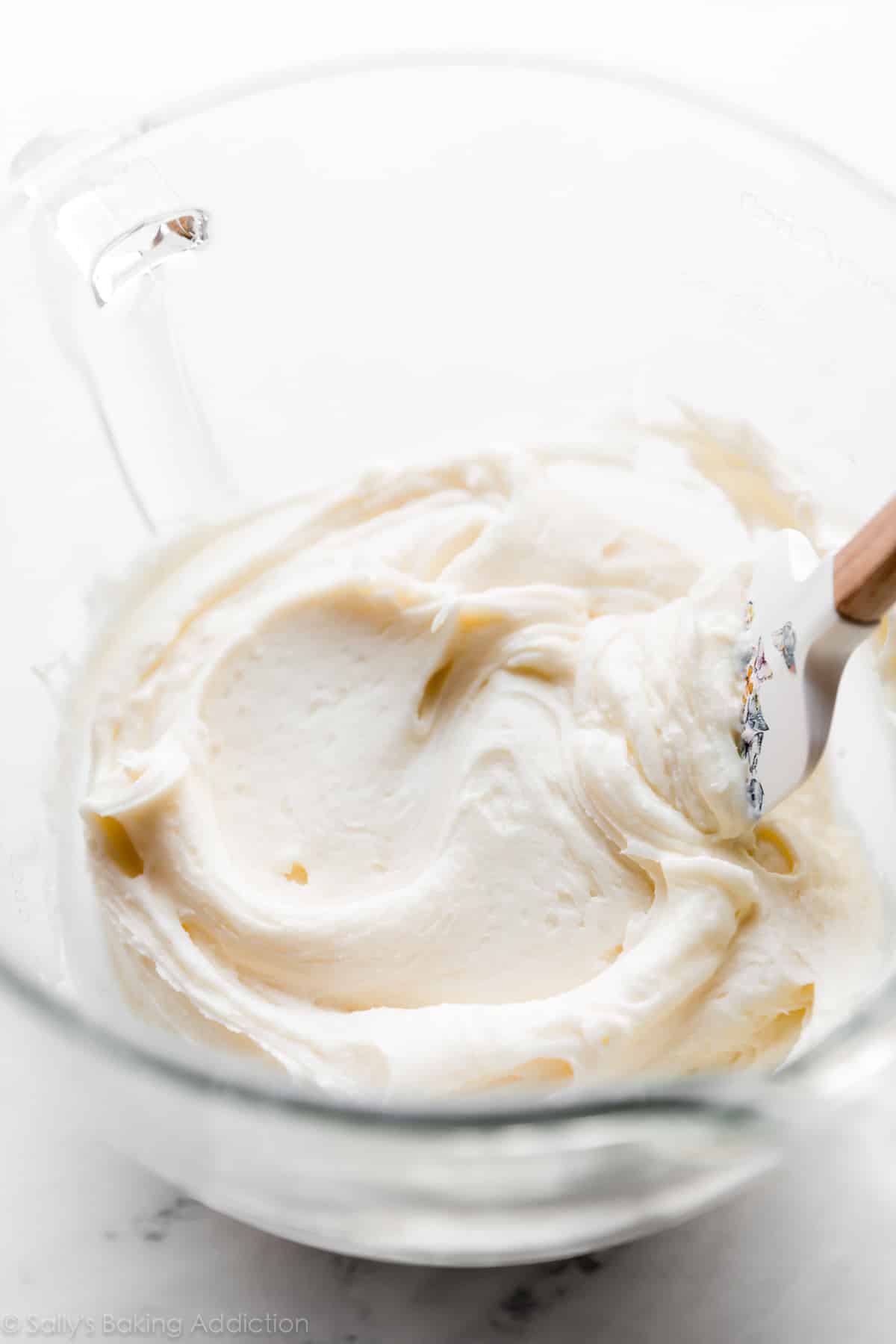
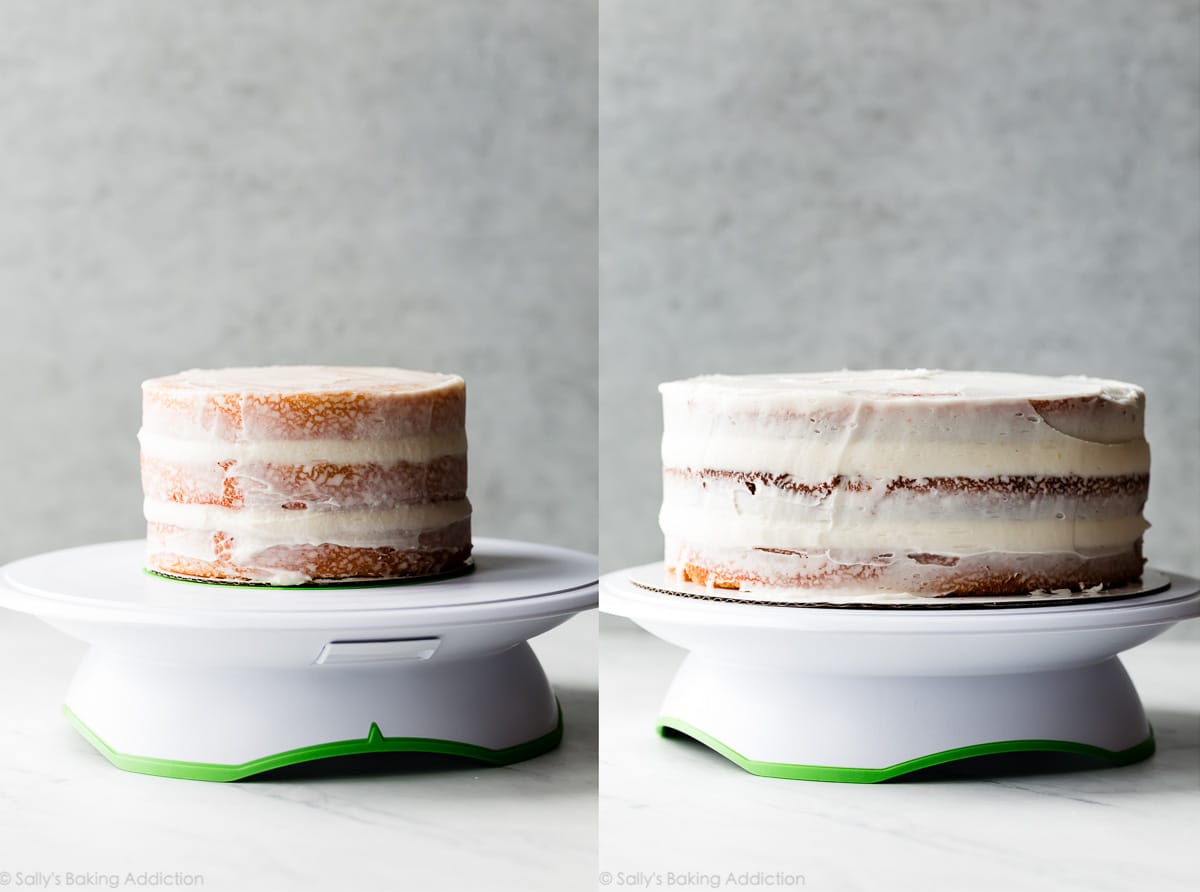
We’ll use my vanilla buttercream recipe (an increased amount, of course) for the decoration. Make two separate batches of frosting, 1 batch for each tier. There’s too much frosting for 1 batch—it will overwhelm your mixer.
You need at least 8-9 cups of frosting total which includes the filling, crumb coat, exterior ruffled frosting, and piping. If you desire other flavors of frosting, be sure to find a recipe that yields or adjust to yield 8-9 cups.
How to Keep Air Bubbles Out of Your Buttercream
Over-whipping vanilla buttercream creates air bubbles. The taste is no different, but the buttercream is no longer smooth and velvety.
Here’s how to get rid of air bubbles in your frosting: Ditch the mixer. Grab a wooden or metal spoon and begin stirring the buttercream by hand. Mash the frosting up against the side of the bowl to “pop” the bubbles. Do this until most of the air bubbles pop, about 1-2 minutes. This trick requires a lot of arm muscle!
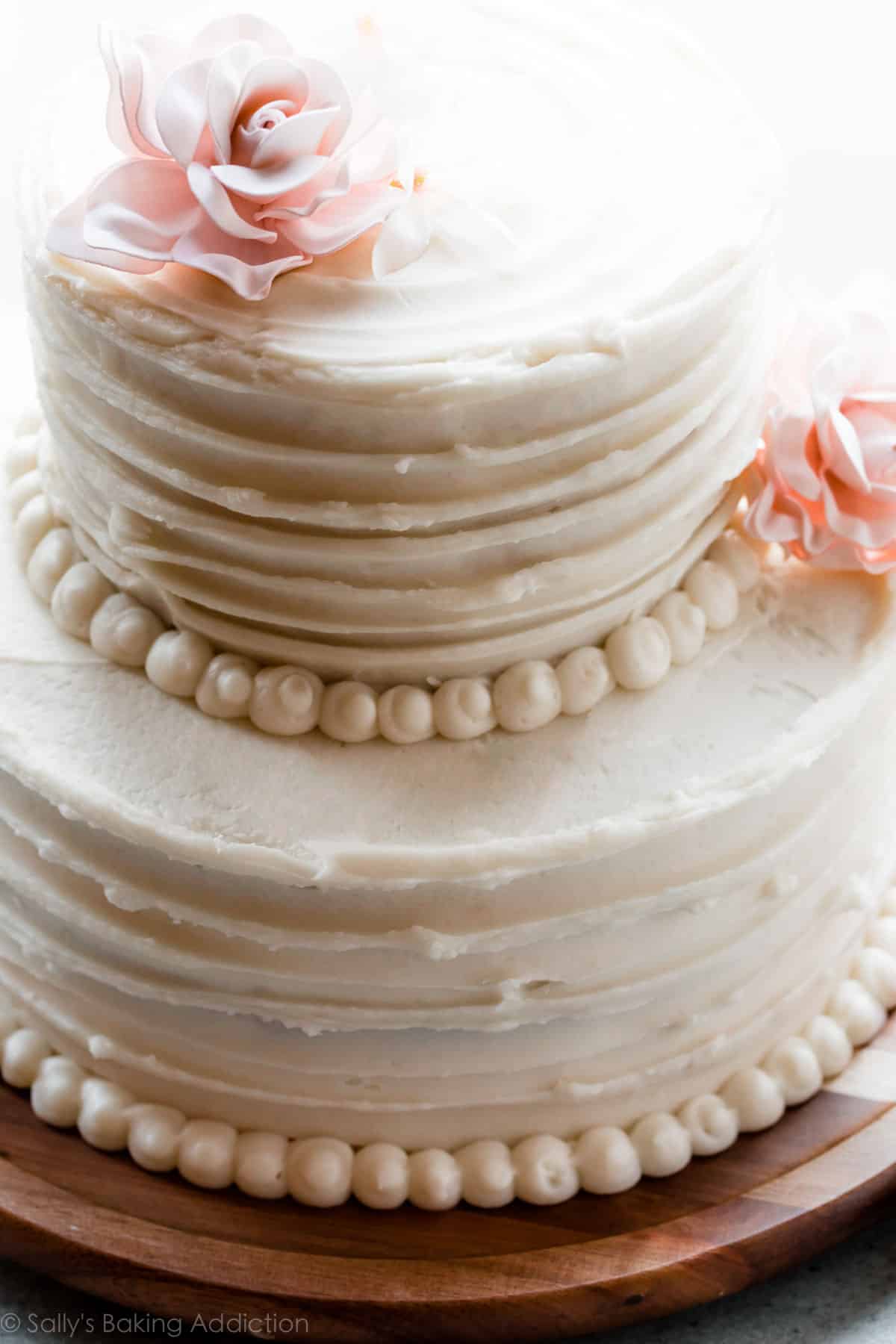
Recommended Special Tools
(Affiliate links)
- Mixer (Handheld or Stand Mixer)
- Egg Separator
- 3 9×2 inch Round Cake Pans
- 3 6×2 inch Round Cake Pans
- Cake Boards (I use 1 6 inch and 1 10 inch. A 9 inch board works for the bottom cake, too. Or purchase this set which also includes cake dowels.)
- Cake Dowels (You need 4. You can use plastic cake dowels too. Plastic dowels are easier to cut.)
- Large Icing Spatula (for large cake)
- Small Icing Spatula (for small cake and for ruffled edge)
- Bench Scraper
- Cake Turner
- Piping Bag (disposable or reusable)
- Round Piping Tip
- Artificial Flower Decor (I used “Cozy Blush” color. Love these!)
- Large Serving Platter or Cake Stand (Pictured is a wooden cake stand I found at Target last year. You can see some of my other favorite cake stands in my list of Gift Ideas for Bakers.)
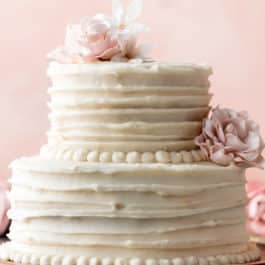
Simple Homemade Wedding Cake Recipe
- Prep Time: 5 hours (includes baking, cooling, decorating)
- Cook Time: 45 minutes
- Total Time: 6 hours
- Yield: 30-35 servings
- Category: Dessert
- Method: Baking
- Cuisine: American
Description
This is a recipe for a completely homemade 2 tier wedding cake. For best taste and texture, and to avoid overwhelming your mixer, make each tier (cake) and each batch of frosting separately.
Ingredients
9-Inch Bottom Tier
- 3 and 2/3 cups (433g) cake flour (spooned & leveled)
- 1 teaspoon salt
- 1 teaspoon baking powder
- 3/4 teaspoon baking soda
- 1 and 1/2 cups (340g) unsalted butter, softened to room temperature
- 2 cups (400g) granulated sugar
- 3 large eggs + 2 additional egg whites, at room temperature
- 1 Tablespoon pure vanilla extract (yes, Tbsp!)
- 3/4 cup (180g) full-fat sour cream, at room temperature
- 3/4 cup (180ml) whole milk, at room temperature
6-Inch Top Tier
- 1 and 3/4 cups (207g) cake flour (spooned & leveled)
- 1/4 teaspoon salt
- 3/4 teaspoon baking powder
- 1/4 teaspoon baking soda
- 1/2 cup (8 Tbsp; 113g) unsalted butter, softened to room temperature
- 1 cup (200g) granulated sugar
- 1 large egg + 1 additional egg white, at room temperature
- 2 teaspoons pure vanilla extract
- 1/2 cup (120g) full-fat sour cream, at room temperature
- 1/2 cup (120ml) whole milk, at room temperature
Frosting for 9 inch cake & piping
- 2 cups (452g) unsalted butter, softened to room temperature
- 8 cups (960g) confectioners’ sugar
- 6 Tablespoons (90ml) whole milk or heavy cream
- 1 and 1/2 teaspoons pure vanilla extract
- 1/8 teaspoon salt
Frosting for 6 inch cake
- 1 cup (16 Tbsp; 226g) unsalted butter, softened to room temperature
- 4 – 5 cups (480-600g) confectioners’ sugar
- 1/4 cup (60ml) heavy cream or whole milk
- 1 teaspoon pure vanilla extract
- salt, to taste
Instructions
- Before beginning this recipe, watch the video tutorial above, read the entire blog post, read the recipe instructions, and review the recipe notes. Make sure you’re prepared with the recommended special tools, which are listed right above this recipe and in the recipe Notes section.
- Make each cake separately. Start with the bottom tier (9-inch cake). Preheat oven to 350°F (177°C). Grease three 9×2 inch round cake pans, line with parchment paper rounds, then grease the parchment paper. Parchment paper helps the cakes seamlessly release from the pans. (If it’s helpful, see this parchment paper rounds for cakes video & post.)
- Whisk the cake flour, salt, baking powder, and baking soda together. Set aside. Using a handheld or stand mixer fitted with a paddle or whisk attachment, beat the butter and sugar together on high speed until smooth and creamy, about 3 minutes. Scrape down the sides and up the bottom of the bowl with a silicone spatula as needed. Beat in the 3 eggs, 2 egg whites, and vanilla extract on high speed until combined, about 2 minutes. (Mixture will look curdled as a result of the egg liquid and solid butter combining.) Beat in the sour cream. Scrape down the sides and up the bottom of the bowl as needed. With the mixer on low speed, add the dry ingredients until just incorporated. With the mixer still running on low, slowly pour in the milk until combined. Do not over-mix. Whisk it all by hand a few times to make sure there are no lumps at the bottom of the bowl. The batter will be slightly thick. You’ll have 8-9 cups of cake batter. Pour batter evenly into cake pans. Weigh them to ensure accuracy, if desired. Bake for around 23-26 minutes or until the cakes are baked through. To test for doneness, insert a toothpick into the center of the cake. If it comes out clean, it’s done. Allow cakes to cool completely in the pans set on a wire cooling rack. The cakes must be completely cool before frosting and assembling.
- Keep the oven on.
- For the top tier (6-inch cake) prepare three 6×2 inch round cake pans just as you did with the 9-inch cake pans in step 2. (Greasing with parchment paper rounds.)
- Prepare the 6-inch cake batter the same exact way as the bottom tier. You’ll have about 4 cups of cake batter. The batter will be thinner than the bottom tier’s cake batter. Pour batter evenly into cake pans. Weigh them to ensure accuracy, if desired. Bake for around 18-22 minutes or until the cakes are baked through. To test for doneness, insert a toothpick into the center of the cake. If it comes out clean, it’s done. Allow cakes to cool completely in the pans set on a wire rack. The cakes must be completely cool before frosting and assembling.
- Using a large serrated knife, slice a thin layer off the tops of all the cakes to create a flat surface. This is called leveling off the cakes. Discard the leveled off piece (or crumble over ice cream!).
- Make the frosting for the 9-inch cake (which is enough for the piping detail, too): In a large bowl using a handheld mixer or stand mixer fitted with a paddle attachment, beat the butter on medium speed until creamy, about 2 minutes. Add confectioners’ sugar, milk, vanilla extract, and salt with the mixer running on low. Increase to high speed and beat for 2 minutes. Add more confectioners’ sugar if frosting is too thin, more milk if frosting is too thick, or an extra pinch of salt if frosting is too sweet.
- You can prepare the rest of the frosting now (step 11), if desired, or begin decorating the 9-inch tier. Place your 9-10 inch cake board on your cake turner. Place 1 cake layer on your cake board. Using a large icing spatula, evenly cover the top with a scant 1 and 1/2 cups of frosting. Top with 2nd cake layer and evenly cover the top with a scant 1 and 1/2 cups of frosting. Top with the third cake layer. Using about 1-1 and 1/4 cups of frosting, spread it all over the top and sides in a thin layer, also called a crumb coat. A large icing spatula and bench scraper are helpful for applying the crumb coat. Set leftover frosting aside at room temperature. If you are decorating this cake in stages over 1-2 days, cover and refrigerate this leftover frosting.
- Using the cake board to pick up the cake (be careful, it’s heavy), place the cake in the refrigerator to help set the crumb coat as you work on the top tier.
- Make the frosting for the 6-inch cake, just as you prepared the 1st batch of frosting. (Step 8.) Before adding any salt, taste the frosting, then add a pinch if desired. I always add a small pinch.
- Place your 6-inch cake board on your cake turner. Place 1 6-inch cake layer on your cake board. Using a small icing spatula, evenly cover the top with a scant 3/4 cup of frosting. Top with 2nd cake layer and evenly cover the top with a scant 3/4 cup of frosting. Top with the third cake layer. Using about 3/4 cup of frosting, spread it all over the top and sides in a thin layer, also called a crumb coat. A small icing spatula and bench scraper are helpful for applying the crumb coat. Set leftover frosting aside at room temperature. If you are decorating this cake in stages over 1-2 days, cover and refrigerate this leftover frosting.
- Using the cake board to pick up the 6-inch cake, carefully place the cake in the refrigerator to help set the crumb coat as you work on the exterior frosting on the top tier.
- Remove the bottom tier from the refrigerator (along with the cake board) and place on the cake turner. Apply the remaining frosting for the bottom tier on the cake, reserving about 6-8 Tablespoons for piping detail. I recommend a large icing spatula and bench scraper to apply the outer layer of frosting. For the decorative textured frosting as pictured, see my video above. As shown in the video, use a small icing spatula and run it around the cake while spinning with the cake turner. You will love this look because it’s very easy, but resembles beautiful ruffles. Carefully lift the cake (with the cake board) and place on your serving platter or cake stand.
- Wash and dry 4 cake dowels. Measure the height of the bottom cake. Measure and cut the cake dowels to match. Staying within a 6 inch circle diameter (you can use another 6 inch cake board to “imprint” a 6-inch circle in the very center of the top of the 9-inch cake), insert the dowels into the cake, spacing them about 2 inches apart to form 4 corners of a square. Push the dowels straight down until each touches the bottom cake board. Set aside.
- Remove the top tier from the refrigerator (along with the cake board) and place on the cake turner. Decorate just as you did the bottom tier, including the ruffled textured frosting. I also turn the cake on the cake turner and apply this ruffled look on top of the 6-inch cake, too. This is optional. Along with the cake board, carefully lift the small cake and gently place it in the very center of the bottom tier.
- Piping: After placing the small tier on top, you can pipe leftover frosting around the bottom of it. This covers up any spaces or smears that may have appeared when arranging the top tier. I pipe dots of frosting with Wilton piping tip #12 between the tiers as well as around the bottom of the whole cake. They resemble pretty pearls. To smooth down pointy peaks on these “pearls,” moisten your fingertip with water and gently press down on the peak.
- Add any decorative pieces, such as artificial flowers.
- Cake is best enjoyed within 3 days. Refrigerate cake until ready to serve. After a few hours, the frosting will “set” and you can lightly cover with plastic wrap.
- Cover any leftover cake tightly and refrigerate for up to 1 week.
Notes
- Make Ahead & Freezing Instructions: Assembled cake is best enjoyed within 3 days. Refrigerate assembled cake until ready to serve. After a few hours, the frosting will “set” and you can lightly cover with plastic wrap until ready to display and serve. You can make the cake ahead of time before assembling it, too. The cake layers can be baked, cooled, and covered tightly at room temperature overnight. Likewise, the frosting can be prepared then covered and refrigerated overnight. Let the frosting sit at room temperature to slightly soften for 20 minutes before assembling and frosting. (You may need to beat the refrigerated frosting in the mixer for 1-2 minutes if it’s particularly solid. Feel free to add a Tablespoon of milk or heavy cream to soften it up as it mixes, too.) Crumb-coated cakes can be frozen up to 2-3 months. Cover with 2 layers of plastic wrap and 1 layer of aluminum foil. Freeze. When ready, thaw overnight in the refrigerator. Unfrosted cake layers can also be frozen up to 2-3 months. Thaw overnight in the refrigerator and bring to room temperature before decorating/serving. See how to freeze cakes for detailed instructions on freezing cake layers.
- Special Tools (affiliate links): 9-inch Round Cake Pans | 6-inch Round Cake Pans | Glass Mixing Bowls | Whisk | Electric Mixer (Handheld or Stand) | Silicone Spatula | Egg Separator | Kitchen Scale (optional) | Cooling Rack | Cake Boards (1 6 inch and 1 10 inch, or this set which also includes cake dowels) | Wooden Cake Dowels or Plastic Cake Dowels | Cake Turner | Large Icing Spatula | Small Icing Spatula | Bench Scraper | Piping Bag (Disposable or Reusable) | Wilton #12 Round Piping Tip | Artificial Flower Decor
- Cake Flour: If you can’t get your hands on cake flour, use this cake flour substitute.
- More flavors, fillings, sizes, decoration ideas, and special tools: See blog post above.
- Why is everything at room temperature? All refrigerated items should be at room temperature so the batters mix together easily and evenly. Read here for more information about the importance of room temperature ingredients.
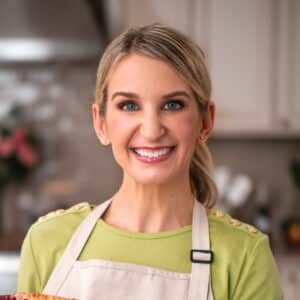
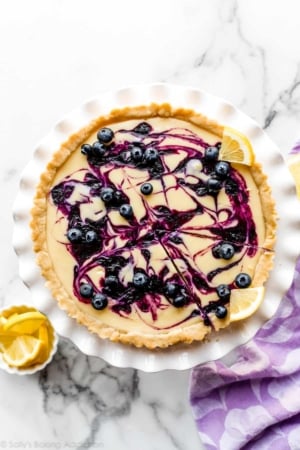
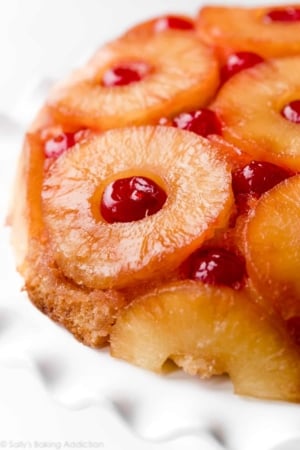
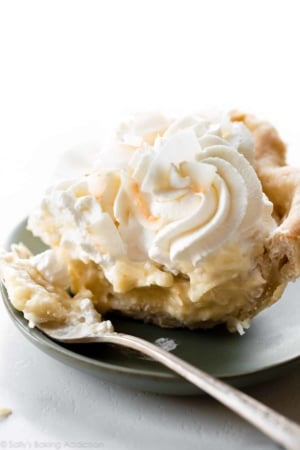
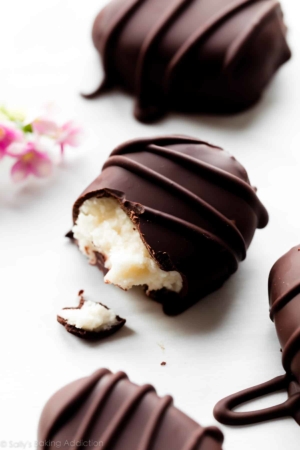
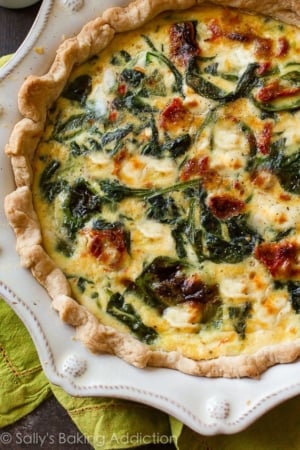
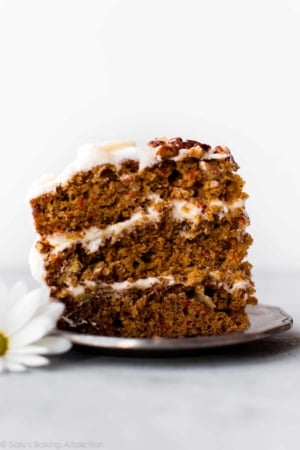






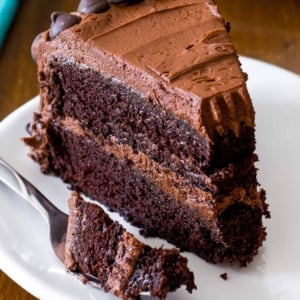
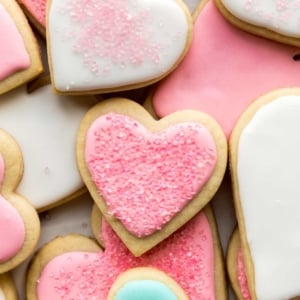
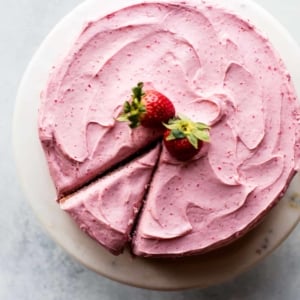
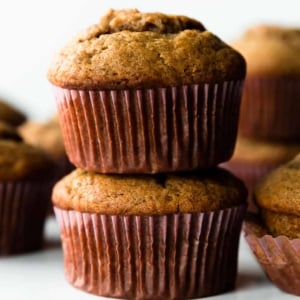
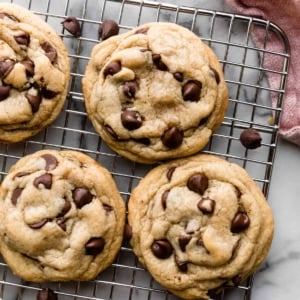
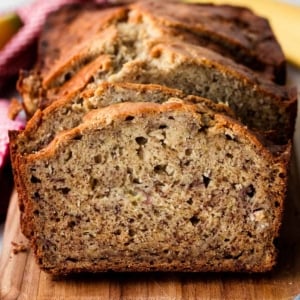
Hi Sally,
Thank you for sharing your recipe. I am planning to make this recipe for my daughter’s birthday. My question is: would the cake come out differently, if I used 2 x 9 inch pans and 2x 6 inch versus 3 pans. How long will be the cooking time be for 2 pans? Many thanks
Hi Nabs, you can make only 2 layers, but there will still be a bit too much batter. Make sure you only fill your pans half way (otherwise you risk overflowing and uneven baking). You can use any leftover batter for a few cupcakes on the side. We’re unsure of the exact bake time, but it will be slightly longer to accommodate for the thicker layers. Keep a close eye on them and use a toothpick to test for doneness. Hope it’s a hit!
Hi Sally, I will be making this cake and have 8×3 inch pans, will this make a difference in the way the cake comes out?
Hi Mary, the bottom tier cake can be baked in three 8 inch pans, the bake time will be a little longer.
Hi, Sally, I love all your cakes. My uncle 50th wedding anniversary on June 22, they want me to bake your cakes! Is for 100 guests.the cakes that, I’m planning to bake, the strawberry one, vanilla, coconut pineapple, white cake, lemon blueberry cake, coconut lemon cake, and the main cake the two tier cake, my question is how many cake do you think, I should bake for 100 people?
Hi Yendi, It depends on the size of the cakes you are making. A 9-inch two layer cake usually serves 10-12 with very generous size slices while a 6-inch cake serves 8.
Hello! Can you use cream cheese frosting on this cake? Will it hold up all day? We just love the cream cheese frosting so much better than buttercream but don’t want the cake to fall apart since it is an outdoor wedding in June.
Hi Trisha, You can absolutely use cream cheese frosting on this cake normally, but it may not be the best candidate for an outdoor wedding in the summer, especially if it is a hot/humid climate. If possible, keep it in the refrigerator as long as possible before placing out, and make sure to keep in out of direct sunlight. If you plan on doing any intricate decorating or piping on the cake, we recommend using buttercream for that instead. Hope this helps!
I made this recipe for my wedding cake (small, intimate ceremony) and loved it. It looked stunning. It wasn’t overly difficult to make. I didn’t make any substitutions and it baked up very well. I also froze the cakes for 2 weeks before I decorated and they thawed just fine.
The only thing I’d change is the sweetness. I think I prefer my cake a little sweeter than this one, so in the future, maybe I’d add a filling or a bit of extra sugar, but as a small wedding cake, this was a stunner! Thanks for the lovely recipe!
Hello! I made the 9” size of this today and was extremely careful not to over mix and weighed my ingredients like always. I ended up with some of the worst tunneling I’ve ever seen in a cake 🙁 One layer literally has two holes that a dime could pass through, including lots of medium sized holes. I’m certain I didn’t overmix. Any other suggestions on how to fix for next time? Thankfully this was a trial run. Thanks!
Hi Megan! Tapping the unbaked cakes on your counter (gently) before baking can get rid of excess air bubbles.
This is my daughter’s favorite cake that I make from your website! She wants this for her wedding cake, and she wants me to make it. Do you have any idea if this would work? She loves a marscapone and berry filling on two of the three layers, along with a strawberry buttercream frosting. I’m a little intimidated by the whole thing, since she also wants a big cookie table at her reception. Thankfully, I can make the cookies 3 months in advance. I know I can freeze the cake layers before the wedding, at 2 months before. Any other helpful suggestions?
Hi Nancy! That sounds absolutely lovely as a wedding cake for your daughter. All our best tips and tricks are in the post above and the recipe notes. We wish you the best and happy baking!
If using buttermilk instead of the sour cream and whole milk how much should I use please?
Hi N, it’s best to follow the recipes as written. They really do turn out best with sour cream and whole milk. We know that the 9-inch cake is great with 1 and 1/2 cups buttermilk (same as this vanilla cake), but we’re unsure about the 6 inch. Let us know if you test it out.
The Cake Looks Gorgeous and comments say easy to make. I am tossing around making my own rather than getting someone else to make it. What would you say the approximate cost to making the two tier cake – like the one your picture? I realize it varies depending on what’s used as the icing, middle, size of cakes, etc.
Hi Karen, we haven’t calculated the cost of baking this cake. Sorry we can’t help more!
I was honored to make my roommates wedding cake last night and it was a hit! My other roommate is getting married in a few months and has asked me to make hers as well-for a slightly larger crowd. Do you have any recommendation for making this into a 3 tiered cake maybe with an 8inch in the middle?
Hi Haley, we’re so glad the cake was a hit! We haven’t tested a 3-tier version of this cake, but a few readers have reported success doing so. Some have done a 12-inch tier on the bottom to keep the tier sizes proportional. Let us know what you decide to try!
I just made this cake. it was so easy. the cake trimmings were out of this world. Can’t wait to cut into it. I add a thin layer of raspberry jam.
Should this cake be served right out of the cooler or should it be taken out hours prior to come to room temperature before serving?
Hi Dave, you can serve the cake right from the refrigerator, but many prefer to bring it out to room temperature for a while before serving. We hope it’s a hit!
I just made this cake for a friend’s wedding this weekend. I was beautiful and worked out perfect. The cake tasted great. I used lemon curd in the 9″ and raspberry compote in the 6″. The swiss buttercream isn’t my preferred frosting (I don’t love the taste) and I love the simpleness and taste of the American Buttercream, but when I practiced with both, I thought the swiss buttercream looked better.
I have never made a stacked cake before and practiced the cake and frosting a few weeks prior. This sample cake continued to taste great for several days.
I made the cakes a week before and froze them. I crumb coated the cakes the day before and put in the fridge without issues.
I highly recommend this recipe!
Hi Sally, thanks for this recipe. Would it be okay to defrost the cakes on the same day as decorating them? Can I ice them partially frozen? Does this cake have to be refrigerated or can I store it fully made in a box in the cold garage overnight? I am in UK winter time. Then travelling 3 hours to venue in morning and the cake will only be eaten at the end of the day around 8pm. Does the cake have to be cooled on journey and then kept in fridge at venue or can I skip the entire fridge process? I’ve read iced buttercream cakes can be kept out at room temp for 3 days. I will be using your icing recipes but for a different chocolate cake recipe for my sisters wedding. Your help is much appreciated. Thank you. Planning to freeze cakes 1-2 weeks before. Defrost, ice, assemble and fully decorate the day before then travel on day and cake needs to keep all day.
Hi Shayne, while some bakers swear by decorating cakes while the layers are still frozen/in the thawing process, we don’t recommend it and prefer to wait until the layers are completely thawed. If the frosted cake is stored in a cooler location overnight, it should be okay to leave it at room temperature for the next day while in transit/at the venue. But use your best judgement—if the venue has a refrigerator available, you may want to stick it in there to make sure the frosting/decor stays nice and set. We hope it’s a hit!
Hi Sally! I am making this recipe for my brothers wedding cake. I was looking to do a red velvet for the bottom and vanilla for the top, both with butter cream icing. I was wondering with the red velvet cake recipe, is that enough for the bottom layer? It mentions that it should be done for 2X9 inch cake tins but I wanted it to be sat across 3. Do i need to bulk it up to make up the third tin? Hope that made sense! Thank you!!
Hi Laura! You can divide that batter between 3 9-inch cake pans as instructed in the recipe Notes.
Hi Sally, quick question, I made the cake but it was shrunk quite a bit once it cooled down. I am from the UK and can’t find any cake flour so just used plain flour. Is there something I am doing wrong or another ingredient I should be adding to get this to rise more? It also felt quite dense and not sure if that is also linked back to the flour? Thank you!
Hi Laura, cake flour is key to this cake’s soft and fluffy texture. It’s likely the plain flour is the culprit for the squat, dense cakes, but be careful not to over mix the batter as that can also cause the cakes to become dense. If you don’t have cake flour available, you can use this cake flour substitute in a pinch. Thank you for giving this recipe a try!
I loved this recipe so much. And this so fantastic
Hey! I made this cake exactly by the instructions…. I double checked everything. I put it in 3 9” pans and baked @375* …. After about 18 minutes I peeped at it and the tops were brown and the edges we’re pulling away from the pans. A toothpick came out clean and it had a spring when push down on the top. I have a feeling my oven is not calibrated correctly thus making it cook too fast. I had to trim the edges away cause they were way to done. That being said, my layers are fairly thin not think like yours in the picture. Would cooking it at too high of a heat cause them not to rise all the way? I’m so bummed
Hi Amanda, these cakes should be baked at 350 degrees (see step 2). The high temperature is likely the culprit for the overbaked and flat cakes. An oven thermometer is also handy to make sure that your oven is properly calibrated and not running hotter than it reads. Hope this helps for next time!
I forgot to add that I made your raspberry filling with fresh berries. The raspberry filling with the cake is gourmet baking.
This cake is absolutely scrumptious delicious! I used this recipe with the sour cream and milk to make just the 9 inch tier for my sister’s 60th birthday. It was a bit small for the decorations I originally chose so I planned something else. At the last minute I decided I really wanted my original idea. I had already textured the icing and placed in refrigerator. It should have been a smooth icing base for the face outline but it still came out beautiful! Everyone couldn’t stop talking about the cake. Follow the recipe exactly and you can’t go wrong.
I wish I could attach a picture of t he e cake.
Hi Sally! I was asked to make a wedding cake for a friends fall wedding. I would like to use your easy apple cake and the best pumpkin cake i’ve ever had recipe to make into a wedding cake. Do you think that would work? Which should be the bottom layer?
Hi Alyson! What fun flavors for a fall wedding cake! We would use the apple cake as the bottom layer. Here is everything you need to know about converting recipes to different Cake Pan Sizes.
How long does this batter last in the refrigerator? I’m making a cake for tomorrow (Sunday), but have to make cupcakes for Wednesday. I was hoping to use what was left of the batter.
Hi Alicia, we don’t recommend storing/saving the leftover batter. The leaveners are activated once the wet and dry ingredients are mixed together, so it’s best to bake the batter shortly thereafter.
Hello! I have not made this yet but I’m very interested in using the ‘not-so-sweet-whipped frosting’ instead of the buttercream one. Do you think I can still make this wedding cake using that frosting instead? (The bride really doesn’t like sweet frosting!)
Hi Meera! For a tall and tiered cake, we don’t think the whipped frosting is a great choice as a filling because it’s so light and fluffy. Instead, we recommend using Swiss Meringue Buttercream which is much sturdier and not nearly as sweet as regular buttercream.
Thank you for this tip. Quick question: Would this cake need to be refrigerated the whole time before eating if I use the Swiss Meringue Buttercream frosting? Or can it sit out for a couple of hours on display during the wedding party? (It won’t be a hot room as we are planning an outdoor event using tents.)
Hi Meera, the frosted cake will be okay out on display for a few hours (especially if it isn’t hot and in direct sunlight).
I made this cake exactly as described. Weighed all my ingredients. It tastes like flour and like a pancake! Terrible recipe and I wasted an entire day and all my money on the ingredients for this.
I love this! Following the recipe except doing it in naked style. Do you have any tips for transport of getting the cake from home to the venue? Separate layers or together?
Hi Natasha! It’s really up to you and what you are most comfortable with. Some bakers prefer to transport the individual tiers in cake boxes or cake carriers, and then assemble on site. Others prefer to transport the assembled cake. Hope it’s a hit!
I made two three tier cakes for my own wedding, as we had two receptions a week apart. I changed the flavours and did one lemon tier and one cherry bakewell, as well as a vanilla on the bottom. I thought the cake was amazing, so moist and delicious and so did my guests. I have never had so many amazing reviews. This will be my go to recipe for all my sponge cakes from now on.
This cake doesn’t taste like a wedding cake. My husband loves wedding cake and I made this for him. We both feel it tastes more like a pancake. The texture is even off. I followed everything to a t. Maybe it’s just a preference I don’t know
I have made some version of this recipe for 4 of my friends weddings now and it has been delicious every time. Thanks so much for creating this and sharing it!